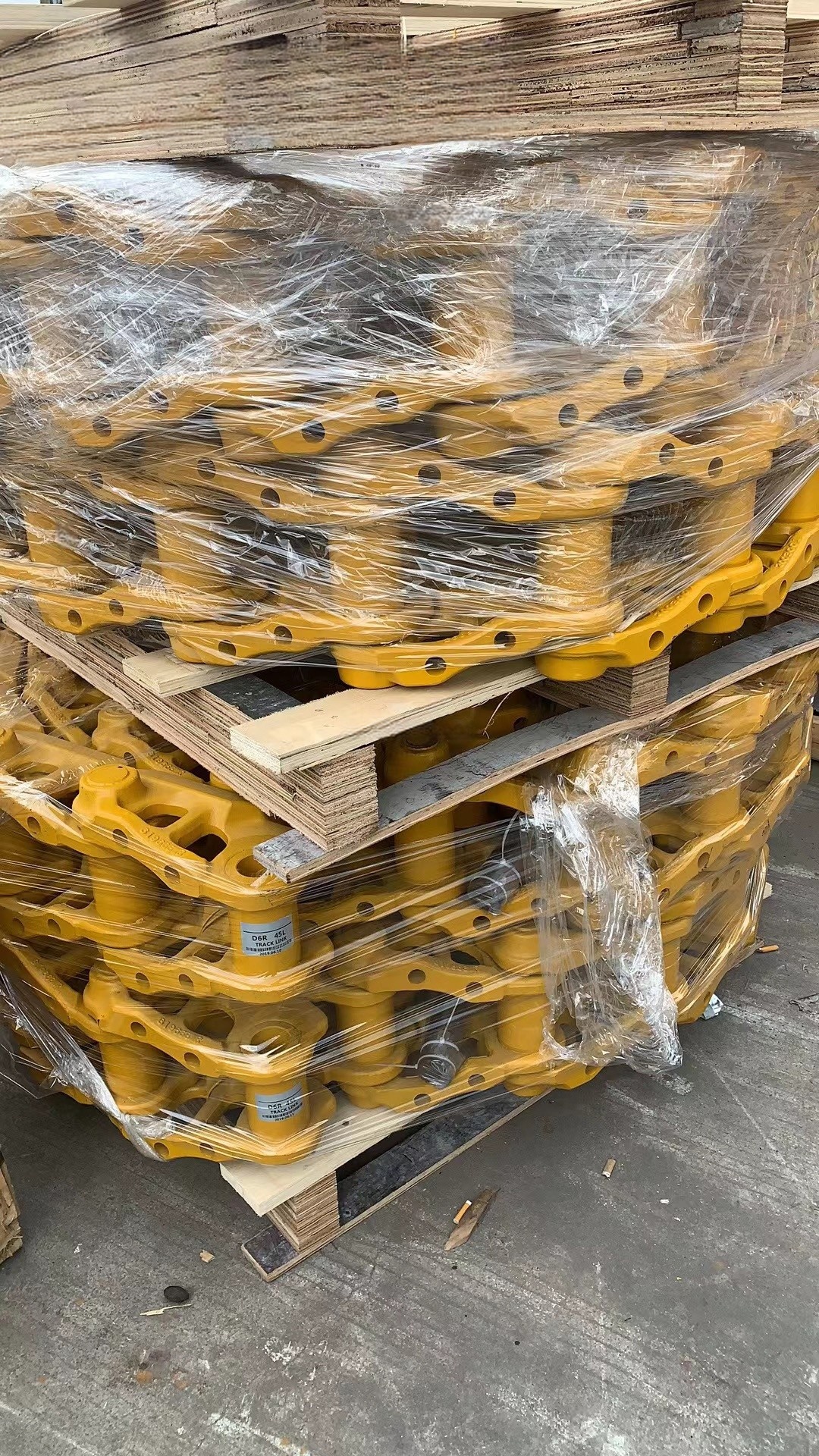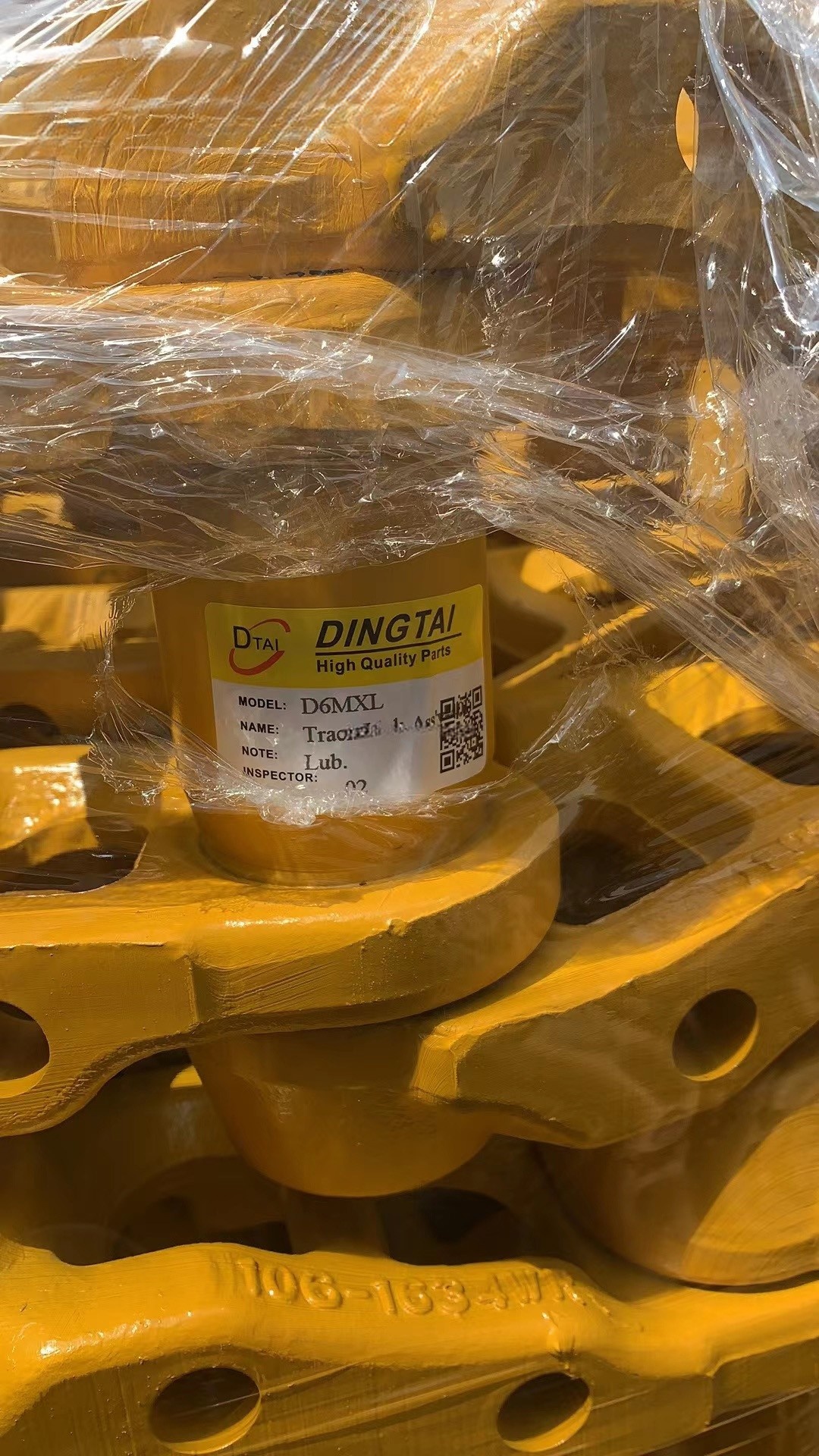A track shoe assy is the foundation of your machine's performance, but making the right choice is more complex than just matching a part number. Choosing incorrectly can destroy a new set of shoes 40% faster and lead to costly damage across your entire undercarriage. This guide will give you the expert insights needed to select the perfect track shoe assembly, ensuring you get maximum service life, performance, and value from your investment.
Last Updated: August 2025 | Estimated Reading Time: 9 minutes

Recommended Image File Name: quality-inspection-of-excavator-track-shoe-assy.jpg
This article will answer for you:
- What a track shoe assembly is and why its individual components matter.
- Why selecting the right excavator track shoe assembly is crucial for your bottom line.
- How to choose the perfect track shoe type for rock, mud, or mixed terrain.
- The hidden wear signs that signal it's time for a replacement.
- How a premium aftermarket shoe track assembly can outperform low-cost options.
- A step-by-step installation guide that prevents the most common failures.
What Exactly Defines a Track Shoe Assembly (Assy) and Its Components?
A track shoe assy, or shoe track assembly, is the complete unit that acts like the tire tread for your dozer or excavator. It consists of the track shoe (the metal plate with grousers for traction) and the high-tensile bolts and nuts used to fasten it to the track chain. Think of it as the boot that connects all of your machine's power to the ground. Every single component, right down to the bolt, plays a role in performance.
The manufacturing process is also critical. For example, the bolt holes on a track shoe can be either punched or drilled. Low-cost shoes often use punching, which creates stress around the hole and can lead to microcracks. A top-tier Track Shoe Assy Manufacture will drill and ream the holes after heat treatment, a process that extends service life by 10-15% by eliminating these stress points. This small detail makes a huge difference in preventing unexpected failures in the field.

Recommended Image File Name: components-of-a-track-shoe-assy.jpg
Why is Choosing the Correct Track Shoe Assy Crucial for Performance and Uptime?
Choosing the right track shoe assy goes far beyond just wear life; it directly impacts fuel efficiency, operator comfort, and the health of your entire undercarriage. The wrong shoe can create a cascade of expensive problems. For example, a shoe that is too narrow for your ground conditions will cause excessive track slip, forcing your machine to burn more fuel for every yard of dirt moved. This loss of traction efficiency hurts your productivity and your profits.
Conversely, a shoe that is too wide for hard ground increases turning resistance, putting immense side-load stress on your track rollers and final drives. Furthermore, improper track chain tension—often a policy issue on job sites—can convert ground impacts into bending stress, causing shoes to bend or crack prematurely. The right shoe, correctly tensioned, balances traction and maneuverability, protecting your whole system.
How Do You Select the Right Type of Track Shoe for Different Ground Conditions?
The single most important factor for success is matching the shoe design to your primary job site terrain. A track shoe that excels in a rocky quarry will fail quickly in soft mud, and vice-versa. True performance comes from a combination of the right steel and the right geometry. For instance, the best rock shoes aren't just "hard"; they have a differential heat treatment with a tough, shock-absorbing core and a harder surface to resist abrasion. This dual-property design can double the service life compared to a simple "through-hardened" shoe.
Here's a quick guide to help you choose:
| Track Shoe Type | Best For | Material/Design Tip | What This Means For You |
|---|---|---|---|
| Single Grouser | High-impact and high-abrasion rock; high traction. | Choose a wide version for better flotation in soft ground. | Maximum grip and penetration for dozers in tough conditions. |
| Double Grouser | Mixed dirt and rock; applications requiring better turning. | Look for reinforced designs if working in demolition or on slopes. | A great all-around choice for excavators, balancing traction and maneuverability. |
| Triple Grouser | General-purpose dirt, clay, and finished surfaces. | Avoid in sticky mud where it can pack and overtighten the chain. | The smoothest operation with the least ground disturbance. |
| Extreme Service | Abrasive, high-impact environments like quarries or mining. | Requires a deep, even heat treatment and a tough core to prevent chipping. | Offers the longest wear life when your machine faces constant abrasion. |
Practical Tips from the Field
- For Rocky Quarries: Select a triple grouser shoe with a reinforced center rib and deep induction hardening to minimize chipping and cracking.
- For Soft/Muddy Terrain: Don't just match the original part. Optimize by choosing a wider single grouser shoe for better flotation and self-cleaning.
- For Cold Climates (below -20°C): Standard steel can become brittle. Ask your supplier for shoes made from alloy steels (Ni-Cr-Mo) to prevent cold-weather fractures.
What are the Telltale Signs Your Track Shoe Assy Needs Inspection or Replacement?
Your track shoe wear pattern is an early warning system for the entire undercarriage—learn to read it. Most operators only check grouser height, but the *way* the shoe is wearing tells a much bigger story. If you see these signs, you can address underlying problems before they become catastrophic failures. Ignoring them means a new set of shoes could be destroyed 40% faster.
- Heel wear is greater than toe wear: This is a classic sign that your track chain pitch has elongated (stretched). The sprocket is no longer engaging correctly, causing scuffing on the back of the shoe.
- Wear on one side of the shoe: If the inner or outer edge is wearing faster, it points to an alignment issue with your track frame or idlers. This is common for excavators working on slopes.
- Chipped or bent grousers: This indicates you're using the wrong shoe type for high-impact conditions, or the steel is too brittle and lacks a tough, shock-absorbing core.
Real-World Case: A mining fleet was experiencing premature shoe cracking. After analysis, we switched them to a custom track shoe assy with a differential heat treatment. The result: a 35% reduction in failures and over $200,000 saved in annual downtime and replacement costs.
For more on this, check out our guide on How to Conduct a 5-Minute Undercarriage Inspection.
How Do OEM and Aftermarket Track Shoe Assemblies Compare in Quality and Price?
The real debate isn't OEM vs. Aftermarket—it's about manufacturing quality, and a premium aftermarket track shoe assy can offer superior value. The biggest hidden variable in the global supply chain is the consistency of the heat-treatment process. Even with the same steel, variations in furnace temperature and quenching can produce shoes with widely different hardness and durability, even within the same batch. This inconsistency is common in low-cost aftermarket parts.
A reputable Track Shoe Assembly Factory like Dingtai, which also serves as an OEM supplier, invests in stringent quality control. We audit our heat-treatment process to ensure every shoe has the optimal balance of a hard, wear-resistant surface and a tough, flexible core. This means you get OEM-level (or better) reliability and performance without the OEM price tag, lowering your total cost of ownership.
Can You Provide a Step-by-Step Guide for Safe Track Shoe Assy Installation?
Yes, and the most critical step is achieving correct bolt clamping force—something most mechanics get wrong. Loose bolts are not just an operator issue; they are often caused by incorrect installation. For example, many mechanics oil the bolt threads before tightening, believing it helps. In reality, this lubrication can reduce the actual clamping force by up to 40%, leading to bolts that loosen quickly under vibration.
Follow these expert steps for a secure installation:
- Prepare the Surface: Thoroughly clean the track chain mounting surface. Any dirt or rust will prevent the shoe from seating correctly.
- Use New Hardware: Always install new track bolts and nuts with a new set of shoes. Reusing old, stretched bolts is a recipe for failure.
- Torque in Sequence: Tighten the bolts in a star pattern to the manufacturer's recommended torque value using a calibrated torque wrench.
- Re-Torque After 50-100 Hours: This is the most crucial step. After the machine has worked for a day or two, go back and re-check the torque on every bolt. This accounts for any initial settling and ensures a permanent, secure fit.
How Can You Maximize Your ROI When Purchasing a New Track Shoe Assembly?
Maximize your return on investment by thinking beyond the price per shoe and focusing on the total solution. The best Track Shoe Assembly Suppliers don't just sell parts; they offer expertise. The biggest competitive advantage comes from purchasing a "site-specific kit." This means you get a matched set of shoes, bolts, and nuts that are optimized for your machine, your job site's ground conditions, and your budget. This strategy has been proven to reduce premature failures by up to 35%.
This approach prevents mixing shoes of different hardness or geometry on the same track chain, which can cause uneven wear and stress. By partnering with a supplier who can provide this level of technical bundling, you ensure every component works in harmony, dramatically extending the life of your entire undercarriage and delivering the lowest possible operating cost per hour.
Frequently Asked Questions
Q1: Is re-welding worn grousers on a track shoe assembly a good idea?
It can be, but only if the track chain is not significantly stretched. If the chain pitch has elongated, the engagement geometry with the sprocket is already wrong. Welding new material onto the grouser won't fix this and the new material will wear away very quickly.
Q2: What is the most common cause of a track shoe assy failing prematurely?
Aside from choosing the wrong shoe type, the most common cause is improper bolt installation. Insufficient clamping force allows for micro-movements between the shoe and the chain, which elongates the bolt holes and eventually leads to bolt fatigue and failure.
Q3: How much does an excavator track shoe assembly cost?
The price varies widely based on size and quality. Instead of focusing on the initial purchase price, calculate the cost per hour of operation. A slightly more expensive, higher-quality shoe that lasts twice as long provides a far better return on investment.
Conclusion & Key Takeaways
Choosing the right track shoe assy is a technical decision that directly impacts your profitability. To make the best choice, you must look beyond the surface. Success hinges on matching the shoe's design and metallurgy to your specific application, ensuring flawless installation with correct bolt torque, and reading wear patterns as a diagnostic tool. By prioritizing quality and partnering with a knowledgeable supplier, you can turn your undercarriage from a cost center into a competitive advantage.
Ready to boost your machine's performance and reduce downtime? The next step is to evaluate your current setup and consult an expert. Contact our team at Dingtai for a free, no-obligation analysis of your needs. We'll help you select a high-performance track shoe assy solution that is engineered to last and optimized for your specific operational challenges. Don't guess—get the right parts the first time.
About Dingtai Engineering Machinery
For over 20 years, Dingtai has been a premier manufacturer of undercarriage parts for the world's leading bulldozer and excavator brands. As an ISO9001 and SGS-certified OEM supplier, we bring the same rigorous quality control and engineering excellence to our aftermarket products. We specialize in creating a durable, reliable track shoe assy and other components that lower your total cost of ownership. Our 100% pre-shipment inspection guarantees you receive parts you can trust to perform in the toughest conditions.
Get an expert consultation today. Contact Us on WhatsApp or Email Us Your Specs for a competitive quote.
Last Updated: August 2025